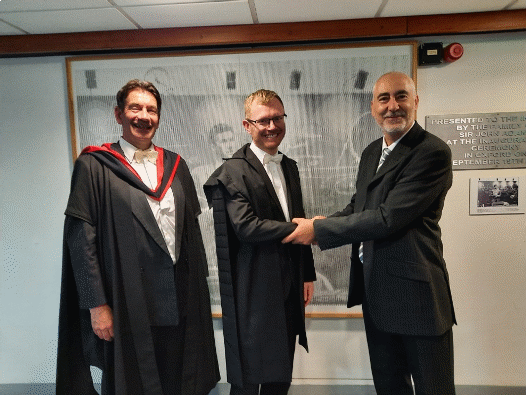
Rob Williamson (centre) with internal examiner Prof. Phil Burrows (left) and external examiner Dr. Elias Métral from CERN (right).
Rob Williamson, part-time DPhil student of the University of Oxford and full-time employee of ISIS (STFC) at the Rutherford Appleton Laboratory, successfully defended his thesis in June.
Rob joined the JAI back in October 2014 having worked at the ISIS Neutron and Muon Source for 8 years, following an undergraduate MPhys degree at Trinity College, Oxford. ISIS is a world-leading centre for research in the physical and life sciences through the production and use of neutrons and muons with operation centred on an 800 MeV rapid cycling synchrotron (RCS) accelerating high-intensity proton beams.
Rob’s thesis focused on beam instabilities encountered in high-intensity hadron accelerators and their impact on operation, especially their role as an intensity and efficiency limitation due to associated beam-loss and activation that restricts hands-on maintenance of the accelerators. On the ISIS synchrotron, a head-tail type instability was measured and characterised as a function of key beam and lattice parameters in both RCS mode and in a new operating mode: bunched beams stored at injection energy. These experimental results were compared with detailed instability simulations and theoretical predictions.
The thesis highlighted limitations in present theories and models, the development of which are important for the better performance of both current and future high-intensity hadron machines. Of particular interest were the impact of transverse space charge on the instability dynamics, which is an area of active research in the community, and the possible methods of mitigating the observed instability.
Following his successful defence, Rob is continuing his role as recently appointed Accelerator Physics group leader at ISIS, including leadership of instability related research and development.